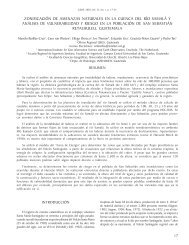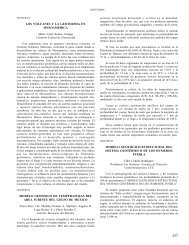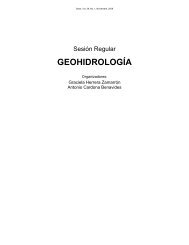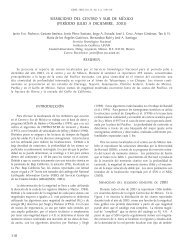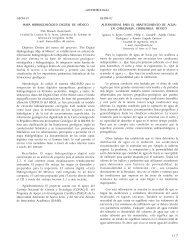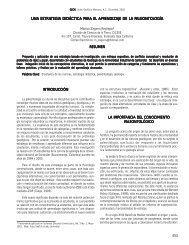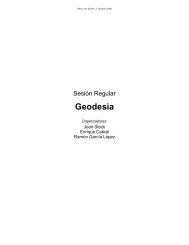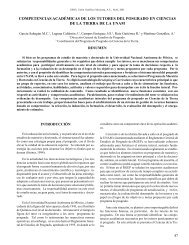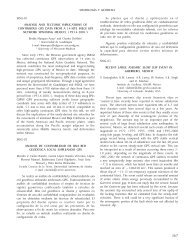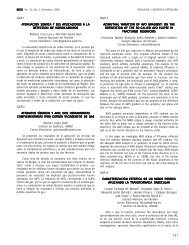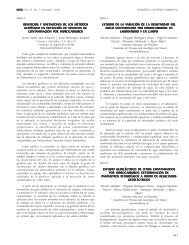Libro de Resúmenes - Unión Geofisica Mexicana AC
Libro de Resúmenes - Unión Geofisica Mexicana AC
Libro de Resúmenes - Unión Geofisica Mexicana AC
You also want an ePaper? Increase the reach of your titles
YUMPU automatically turns print PDFs into web optimized ePapers that Google loves.
VULCANOLOGÍA Geos, Vol. 30, No. 1, Noviembre, 2010<br />
meteorológicos (el clima, la presión, temperatura), y la fuente <strong>de</strong> CO2 a<br />
profundidad.<br />
VUL-24<br />
DIFUSSE EMISSIONS OF CO2 AND H2S IN<br />
STROMBOLI AND VULCANO VOLCANOES<br />
Jácome Paz Mariana Patricia 1 , Cár<strong>de</strong>nas González<br />
Lucio 2 , Inguaggiato Salvatore 3 y Delgado Granados Hugo 1<br />
1 Instituto <strong>de</strong> Geofísica, UNAM<br />
2 Centro Nacional <strong>de</strong> Prevención <strong>de</strong> Desastres<br />
3 INGV, Instituto Nazionale di <strong>Geofisica</strong> e Vulcanologia, Sezione di Palermo<br />
mapajapaz@hotmail.com<br />
Volcanic systems <strong>de</strong>gas through vents or by diffuse flow through the surface.<br />
The concentration of gases in a fumarole or the value of the diffuse flux allow<br />
quantifying the activity of the volcano and its monitoring help to un<strong>de</strong>rstand the<br />
dynamics of volcanoes in or<strong>de</strong>r to anticipate eruptions.<br />
Here we present a methodology and results of diffuse gas measurements ma<strong>de</strong><br />
at Stromboli and Vulcano in July 2010 to recognize the magnitu<strong>de</strong> of diffuse<br />
emissions of CO2 and H2S as well as testing combined CO2, H2S and CH4<br />
sensors incorporated into a portable instrument.<br />
Stromboli and Vulcano are part of the Aeolian Islands volcanic complex.<br />
In the early twentieth century an eruptive period of 15 eruptions began at<br />
Stromboli, including the last two in 2002-2003 and 2007. The volcano has not<br />
stopped to emit gases, ash and lava. Vulcano´s last eruption was between<br />
1888-1892. Currently, Vulcano Island’s activity is concentrated in two fumarolic<br />
fields, one in the north-eastern beach of the island and another southeast of the<br />
crater area.<br />
About 400 measurements of soil CO2 flux was been carried out at Stromboli<br />
island in or<strong>de</strong>r to estimate the total CO2 flux across. The highest values were<br />
found around the top and at the eastern slope. The highest CO2 flux value was<br />
found near the summit: ~81 ppm/s, and the lowest CO2 levels were recor<strong>de</strong>d<br />
in areas near the beach (~10 m): 0.001 ppm/s. The values in those areas have<br />
remained the same since the last eruptions of Stromboli and the values were<br />
higher than in previous years but within the same or<strong>de</strong>r of magnitu<strong>de</strong>.<br />
At Vulcano, about 100 measurements were ma<strong>de</strong> to measure H2S and CO2<br />
fluxes at the beach in the northeast si<strong>de</strong> of the island and on the fumarolic fields<br />
in the crater area. The highest CO2 value was measured in the fumarolic area at<br />
the beach (below sea level): ~575 ppm/s. The lowest CO2 flux was: 10E-7 ppm/s<br />
(southwest of the crater). The highest H2S value was obtained in the beach<br />
fumaroles: 1.31 ppm/s, whilst the lowest H2S levels were obtained southwest<br />
of the crater: 10 E -7 ppm/s. The CO2 flux values in fumarolic fields show no<br />
significant changes to previous years. There is no previous reference for H2S<br />
flux values. High values of both flows are concentrated only in the fumarolic fields<br />
and found no significant diffuse emission. No relationship was found between<br />
CO2 and H2S fluxes.<br />
The CO2, H2S and CH4 <strong>de</strong>tectors response curves show real-time gas<br />
concentrations in the accumulation chamber and allow us to calculate the flow<br />
accurately. The equipment is suitable for field work due to portability and the<br />
efficiency of the batteries and sensors.<br />
VUL-25<br />
SIMULADOR MODULAR DE FLUJOS GRANULARES A ESCALA<br />
(GRANFLOW-SIM): CONSTRUCCIÓN Y APLIC<strong>AC</strong>IONES<br />
Bartali Roberto, Sarocchi Damiano y Nahmad Molinari Yuri<br />
Universidad Autónoma <strong>de</strong> San Luis Potosí<br />
rbartali@hotmail.com<br />
Se presentan el <strong>de</strong>sarrollo y las aplicaciones <strong>de</strong> un sistema modular diseñado<br />
para realizar estudios <strong>de</strong> flujos granulares a escala. GRANFLOW-SIM es un<br />
aparato que consiste en una estructura metálica que sostiene una rampa<br />
también metálica <strong>de</strong> siete metros <strong>de</strong> largo y <strong>de</strong> ancho variable, con recubrimiento<br />
<strong>de</strong> ma<strong>de</strong>ra y pare<strong>de</strong>s <strong>de</strong> acrílico. La rampa pue<strong>de</strong> ser colocada <strong>de</strong> tal forma<br />
que se puedan variar también pendiente, longitud y velocidad inicial <strong>de</strong>l flujo<br />
granular. A lo largo <strong>de</strong> la rampa y alre<strong>de</strong>dor <strong>de</strong> todo el sistema se encuentran<br />
varios sensores con sus respectivos amplificadores, acondicionadores <strong>de</strong> señal,<br />
computadoras para el interfaces y el almacenamiento <strong>de</strong> datos. Tanto la parte<br />
mecánica como la parte electrónica han sido <strong>de</strong>sarrolladas íntegramente por<br />
los autores. El sistema <strong>de</strong> sensores y <strong>de</strong> cámaras digitales <strong>de</strong> vi<strong>de</strong>o <strong>de</strong> alta<br />
velocidad permiten la medición <strong>de</strong>: velocidad, presión, aceleración, vibración,<br />
granulometría dinámica, fábrica y humedad <strong>de</strong> la masa en movimiento. Estos<br />
datos nos permiten estudiar la reología <strong>de</strong>l flujo, el comportamiento cohesivo<br />
y no cohesivo, la segregación <strong>de</strong>l material, el tipo y cantidad <strong>de</strong> colisiones,<br />
la energía involucrada, la textura <strong>de</strong> los micro-<strong>de</strong>pósitos que se generan,<br />
la capacidad erosiva, y el alcance entre otros. Los materiales granulares<br />
utilizados son varios, <strong>de</strong>s<strong>de</strong> esferas <strong>de</strong> vidrio a material natural <strong>de</strong> varia<br />
<strong>de</strong>nsidad y forma, con un diámetro variable entre arcilla y grava, con diferentes<br />
distribuciones granulométricas. Los experimentos se llevan a cabo con el<br />
objetivo <strong>de</strong> investigar <strong>de</strong> una forma básica los complejos fenómenos que<br />
caracterizan los flujos granulares para compren<strong>de</strong>r mejor su comportamiento,<br />
con recaídas en sectores que varían entre la prevención <strong>de</strong> <strong>de</strong>sastres y en la<br />
mejora <strong>de</strong> los procesos industriales.<br />
VUL-26<br />
COMPORTAMIENTO DINÁMICO DE LOS FLUJOS DE ESCOMBROS:<br />
EVIDENCIAS A PARTIR DE DATOS EXPERIMENTALES<br />
Caballero García Lizeth 1 y Sarocchi Damiano 2<br />
1 UNAM<br />
2 UASLP<br />
lizethcaballero@yahoo.com.mx<br />
El comportamiento dinámico <strong>de</strong> los flujos <strong>de</strong> escombros está controlado por la<br />
interacción entre partículas y por las características <strong>de</strong>l fluido intersticial. Con<br />
el fin <strong>de</strong> estudiar ambos fenómenos, cuatro mezclas <strong>de</strong> agua y sedimentos,<br />
con características <strong>de</strong> flujos <strong>de</strong> escombros cohesivos y no cohesivos, fueron<br />
sometidas a diferentes intervalos <strong>de</strong> tiempo en un tambor rotatorio, conocido<br />
como máquina <strong>de</strong> Los Ángeles. Las variaciones observadas en la distribución<br />
granulométrica y en las características morfológicas <strong>de</strong> las partículas, durante el<br />
tiempo <strong>de</strong> duración <strong>de</strong> los experimentos, fueron correlacionadas con la abrasión<br />
<strong>de</strong> partículas ocurrida durante el transporte.<br />
Las mezclas utilizadas, presentaban distribuciones granulométricas idénticas<br />
en las fracciones <strong>de</strong> -6 a 4phi, variando únicamente las proporciones <strong>de</strong> limo y<br />
arcilla. Para estudiar los cambios en la granulometría, se empleó el tamizado<br />
<strong>de</strong> las muestras a intervalos <strong>de</strong> 1phi y para realizar el análisis cuantitativo <strong>de</strong> la<br />
forma se utilizó el Análisis <strong>de</strong> Fourier y la Geometría Fractal.<br />
Los resultados <strong>de</strong> los experimentos, muestran cambios en la distribución<br />
granulométrica <strong>de</strong> unimodal a bimodal, in<strong>de</strong>pendientemente <strong>de</strong>l contenido y tipo<br />
<strong>de</strong> material fino, <strong>de</strong>bido a procesos <strong>de</strong> interacción entre partículas, que producen<br />
el fracturamiento <strong>de</strong> ciertas clases granulométricas, en particular, -1phi. Estos<br />
cambios en la granulometría <strong>de</strong> los flujos <strong>de</strong> escombros son concordantes con<br />
los observados en <strong>de</strong>pósitos reales y dichas variaciones han sido explicadas<br />
por medio <strong>de</strong> la <strong>de</strong>positación selectiva <strong>de</strong> material y mediante la incorporación<br />
<strong>de</strong> sedimentos, proceso conocido como bulking.<br />
Los resultados <strong>de</strong>l análisis morfológico muestran que las modificaciones más<br />
importantes en la morfología <strong>de</strong> los clastos, ocurren en las primeras etapas <strong>de</strong>l<br />
movimiento <strong>de</strong> los flujos <strong>de</strong> escombros, y que estas variaciones están en función<br />
<strong>de</strong> la composición <strong>de</strong>l fluido intersticial, en particular, <strong>de</strong>l contenido <strong>de</strong> arcilla,<br />
y <strong>de</strong>l diámetro <strong>de</strong> la partícula. A<strong>de</strong>más, los cambios más significativos en la<br />
morfología, ocurren en las clases granulométricas cuya proporción disminuye<br />
dramáticamente durante el tiempo en el cual transcurre el experimento.<br />
VUL-27<br />
MODELO ANÁLOGO DE TIPO CAJA DE ARENA APLICADO A LA<br />
ESTRUCTURA SEMICIRCULAR DE STA. MA. AMAJ<strong>AC</strong>, EDO DE HGO.<br />
Silis Esquivel Jhoanna, Cruz López Salvador,<br />
García Tenorio Felipe y Escamilla Casas José Cruz<br />
ESIA Ticomán, IPN<br />
jhoannase_cl85@hotmail.com<br />
En las últimas décadas ha sido <strong>de</strong> gran interés el estudio <strong>de</strong> las cal<strong>de</strong>ras<br />
volcánicas por sus implicaciones en riesgo geológico, la formación <strong>de</strong><br />
yacimientos <strong>de</strong> minerales rentables, actividad termal que es explotada en las<br />
plantas geotérmicas y a la actividad sísmica.<br />
Las cal<strong>de</strong>ras volcánicas, constituyen estructuras <strong>de</strong> colapso, que en el sistema<br />
natural se observan <strong>de</strong> formas circulares, ovaladas ó elípticas, cuyos tamaños,<br />
las clasifican en dos grupos: cal<strong>de</strong>ras pequeñas



![Libro de resúmenes [revisión final, 172 páginas] - UGM](https://img.yumpu.com/51565067/1/190x245/libro-de-resamenes-revisian-final-172-paginas-ugm.jpg?quality=85)
